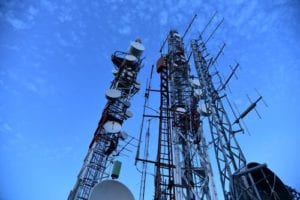Written by Joyce Smith, BS. Researchers observing a human population exposed to radiations emitted from mobile towers found that genetic polymorphism and antioxidant genes were significantly associated with genetic damage.
 Today India has approximately 800 million users of mobile phones and mobile handsets that are connected to approximately 375,000 towers, the majority of which are near residential and office buildings, potentially exposing millions of people who reside within these high-radiation zones. Determining how cell tower electromagnetic radiation exposure affects populations around the world is an ongoing endeavor. Cell towers transmit radiation continuously without any interruption, so people living within hundreds of meters from the tower receive 10,000 – 10,000,000 times greater signal than that required for mobile communications. Among the proposed dangers is the increase in oxidative stress and its formation of excessive free radicals that create oxidative DNA damage 1,2. Reactive oxygen species (ROS) are chemically reactive oxygen molecules (free radicals) that function in a protective capacity against infections; but when excessive, they can damage tissues 3,4 . While Wolf et al 5 found an association between increased cancer incidence and cell phone station proximity, little research has been done on the harmful effects of mobile tower radiation to humans.
Today India has approximately 800 million users of mobile phones and mobile handsets that are connected to approximately 375,000 towers, the majority of which are near residential and office buildings, potentially exposing millions of people who reside within these high-radiation zones. Determining how cell tower electromagnetic radiation exposure affects populations around the world is an ongoing endeavor. Cell towers transmit radiation continuously without any interruption, so people living within hundreds of meters from the tower receive 10,000 – 10,000,000 times greater signal than that required for mobile communications. Among the proposed dangers is the increase in oxidative stress and its formation of excessive free radicals that create oxidative DNA damage 1,2. Reactive oxygen species (ROS) are chemically reactive oxygen molecules (free radicals) that function in a protective capacity against infections; but when excessive, they can damage tissues 3,4 . While Wolf et al 5 found an association between increased cancer incidence and cell phone station proximity, little research has been done on the harmful effects of mobile tower radiation to humans.
In the present study by Gulati et al, 6 significant genetic damage was found in subjects exposed to a much lower power density of 12.2mW/m2 than India’s prescribed radiofrequency reference. The study consisted of 116 individuals residing near mobile towers and 106 healthy controls who resided more than 800 meters from the mobile towers or other sources of radiation. Demographic data included all previous exposure to radiation sources, including medical and kitchen appliances such as microwaves in the past 12 months. A standard questionnaire provided data such as age, gender, diet, mobile usage, exposure duration, and consumption habits (smoking, tobacco consumption, drinking habits, etc.) on all participating subjects. Excluded were those who had recent x-rays, chronic diseases such as autoimmune, or a recent antibiotic or vaccination. Genotyping and determining enzyme activity levels for manganese superoxide dismutase (MnSOD) and catalase (CAT) as well as lipid peroxidation assays were done on all participants.
In participating subjects, researchers found a significantly lower mean value of manganese superoxide dismutase (MnSOD) enzyme activity, catalase (CAT) enzyme activity, and a higher mean value of lipid peroxidation assay compared to control subjects (P<0.05 for all). The lowest levels of MnSOD and CAT enzyme activity and highest levels of lipid peroxidation assay and highest maximum cell damage were evident at approximately 150 meters from the cell towers. When genotyping antioxidant genes, researchers found that polymorphisms in antioxidant MnSOD and CAT genes contributed significantly to higher levels of ROS and potential DNA damage. MnSOD activity was significantly higher in the mutant group compared to the wild-type group of the MnSOD gene; however, in the calalase gene, enzyme activity was significantly lower in the mutant group when compared to the wild-type group.
This current study demonstrated a significant association of genetic polymorphism of antioxidant genes with genetic damage in a human population exposed to radiation emitted from mobile towers. However, the issue of mobile tower radiation is still controversial. In this study researchers found one case of cancer out of 115 individuals exposed to radiation for more than nine years. This study can serve as a reference for future studies with larger numbers of people.
Source: Gulati, Sachem, Anita Yadav, Neural Kumar, Kane Praia, Neural K. Aggarwal, and Raman Gupta. “Phenotypic and genotypic characterization of antioxidant enzyme system in human population exposed to radiation from mobile towers.” Molecular and cellular biochemistry 440, no. 1-2 (2018): 1-9.
© Springer Science Business Media, LLC 2017
Click here to read the full text study.
Posted October 21, 2019.
Joyce Smith, BS, is a degreed laboratory technologist. She received her bachelor of arts with a major in Chemistry and a minor in Biology from the University of Saskatchewan and her internship through the University of Saskatchewan College of Medicine and the Royal University Hospital in Saskatoon, Saskatchewan. She currently resides in Bloomingdale, IL.
References:
- Blank M, Goodman R. DNA is a fractal antenna in electromagnetic fields. International Journal of radiation biology. 2011;87(4):409-415.
- Burlaka A, Tsybulin O, Sidorik E, et al. Overproduction of free radical species in embryonal cells exposed to low intensity radiofrequency radiation. Experimental oncology. 2013(35,№ 3):219-225.
- Desai NR, Kesari KK, Agarwal A. Pathophysiology of cell phone radiation: oxidative stress and carcinogenesis with focus on male reproductive system. Reproductive Biology and Endocrinology. 2009;7(1):114.
- Bandyopadhyay U, Das D, Banerjee RK. Reactive oxygen species: oxidative damage and pathogenesis. Current Science-Bangalore-. 1999;77:658-666.
- Wolf R, Wolf D. Increased incidence of cancer near a cell-phone transmitter station. International Journal of Cancer. 2004;1(2):123-128.
- Gulati S, Yadav A, Kumar N, Priya K, Aggarwal NK, Gupta R. Phenotypic and genotypic characterization of antioxidant enzyme system in human population exposed to radiation from mobile towers. Molecular and cellular biochemistry. 2018;440(1-2):1-9.
